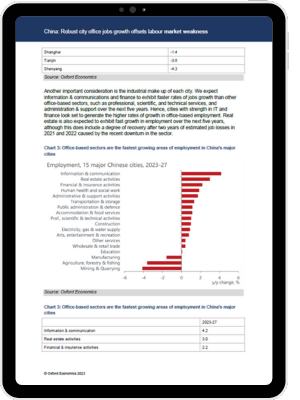Robust city office jobs growth offsets labour market weakness in China

China’s major cities will be primary drivers of office-based employment growth over the next five years, with 15 of the largest cities set to create more than a third of all new office jobs across the country. That is happening at a time when China’s overall level of employment has entered a period of long-term structural decline as the country grapples with its deteriorating demographics. The rise of office-based jobs is part of the country’s pivot into a more services-led economy.
What you will learn:
- In the five years to 2027, total employment in China overall is set to fall on average by 0.2% per year, whereas employment in office-based sectors is forecast to rise by 2.6%.
- The country’s major tech and finance cities such as Hangzhou, Shenzhen, and Guangzhou, lead the growth rankings of office-based employment. In growth terms, Shanghai and Beijing are weaker, but given their overall size, they are still expected to generate a high number of office-based jobs. Overall employment in those cities, however, is likely to fall given job losses in industrial sectors and the constraints on labour force growth applied by each city’s population caps.
- Some of China’s leading western and central cities, such as Xi’an, are forecast to compete with the country’s other major cities in terms of growth in office-based employment over the next five years as they grow in stature in higher-value services.
Tags:
Related posts

Post
Understanding Australia’s Goods Trade Dynamics in 2025
2. Explore Australia's goods trade dynamics, with rising exports and falling imports. Learn how global demand impacts the trade balance and future projections.
Find Out More
Post
Roadblocks to China’s chip self-sufficiency dream
China is unlikely to achieve full chip self-sufficiency any time soon because of high technological hurdles in producing advanced manufacturing equipment and materials. The self-sufficiency target now stretches well beyond actual fabrication to include the entire chip supply chain as China struggles to acquire necessary input and machinery into the production process.
Find Out More
Post
Five lessons for businesses navigating tariffs and trade turmoil
In a rapidly evolving global trade environment, businesses must stay ahead of changing tariffs and regulatory demands. Our latest blog offers practical guidance on navigating tariffs, understanding key trade strategies, and leveraging accurate HS code classifications to optimize your supply chain. Explore essential insights that will help your business manage trade uncertainty, ensure compliance, and unlock new growth opportunities.
Find Out More